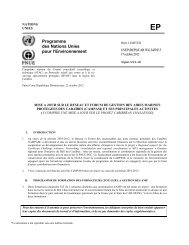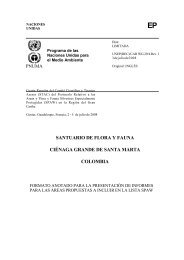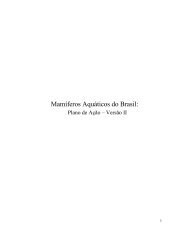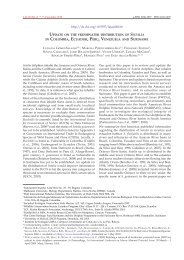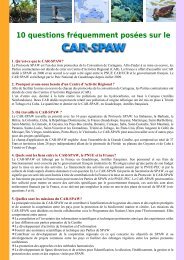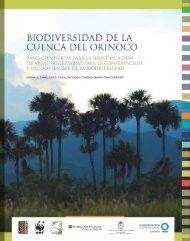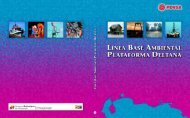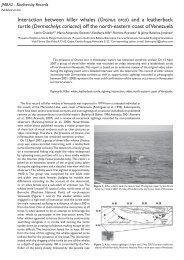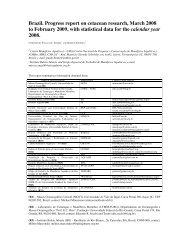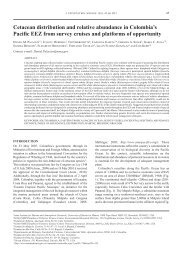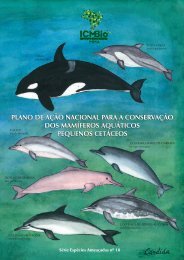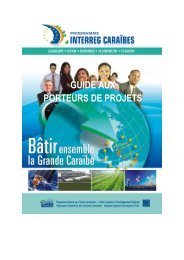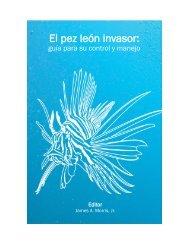1 - CAR-SPAW-RAC
1 - CAR-SPAW-RAC
1 - CAR-SPAW-RAC
You also want an ePaper? Increase the reach of your titles
YUMPU automatically turns print PDFs into web optimized ePapers that Google loves.
EXECUTIVE SUMMARYBIODIVERSIDAD DE LA CUENCA DEL ORINOCO:II. ÁREAS PRIORITARIAS PARA LA CONSERVACIÓNY USO SOSTENIBLEC. LassoC. Lassoland uses. The structure of the original area occupied bythis ecosystem has been altered and considerably reduced.Different types of fires, activities associated with oilexploration, storage and extraction, and forest plantationsof pine trees Pinus caribaea var. hondurensis (in Venezuela,and other monoculture crops in Colombia) make upthe current set of threats that put this ecosystem and theservices it provides to local human populations at risk.Use and management of wildlife in theColombian Orinoco Basin: hunting andillegal traffickingInformation is presented on wildlife harvest in theColombian Orinoco Basin. First, an assessment of huntingby indigenous peoples is given, where existing dependenceon mammals, birds and reptiles as protein sources isdetailed. In addition, we present an analysis of the useof wildlife, and conflicts that have arisen, with regardsto inhabitants of the plains and the particular case offelines. As an illustrative case study, an evaluation of thepatterns of use for three endangered species is presented:the Arrau and Terecay turtles and the Manatee, for whichpopulations have been drastically reduced. The Capybaraharvest is analyzed in light of its ecological implicationsand illegal traffic of the species in the region. In conclusion,wildlife harvesting is generating negative impacts thatrequire appropriate measures of species and ecosystemmanagement, as well as standardized evaluation proceduresthat will allow quantification of these impacts.Continental turtles of the Venezuelan OrinocoBasin: current situation and initiatives for theirconservation and sustainable useAlmost 80% of the continental turtles of Venezuela arefound in the Orinoco Basin and many of them are usedlocally and regionally as food for subsistence, folk medicinalremedies or are commercially harvested. Unfortunately,this harvest is not sustainable and has caused somespecies to become threatened or endangered. We presenta synthesis of our knowledge about the biodiversityand biogeography of the turtles of the Orinoco Basinin Venezuela, risk and threat factors as well as initiativesundertaken to promote their conservation during morethan twenty years, with special emphasis on the activitiesof the La Salle Foundation’s program for the Conservation,Management, Sustainable Use of the Continental Turtles ofVenezuela. This information will be useful to evaluate thegoals that have been reached and to better our efforts andfocus future efforts.FUDECI and the conservation of the OrinocoFreshwater Turtle (Podocnemis expansa), theTerecay Turtle (Podocnemis unifilis) and theOrinoco Crocodile (Crocodylus intermedius):results and proposal for binational actionsThe Fundación para el Desarrollo de las Ciencias Físicas,Matemáticas y Naturales (FUDECI) has taken actionand carried out research to promote the recuperationof endenagered species for the last 18 years. With theintent to reinforce natural populations, a breeding facilitywas established in the state of Amazonas for Podocnemisexpansa, Podocnemis unifilis and Crocodylus intermedius;it has achieved the reproduction, rearing and releaseof juveniles in several different regions of Venezuela.These actions are considered vital for the recuperation,investigation and management of these species within theirnatural ranges of distribution. To assure their recovery,cooperative efforts between both countries are required.Specific activities and strategic habitat zones are suggestedto initiate this collaboration in the Capanaparo, Meta, andArauca River drainages as well as the Atabapo-PuertoCarreño axis.Priorities for “in situ” biodiversity conservationin the Colombian portion of the Orinoco BasinThe identification of priority sites for “in situ” biodiversityconservation has been a fundamental tool in the process ofregional environmental planning. In the eastern plains ofColombia, these procedures become even more importantin light of recent interest and efforts of commercialinterests to “colonize” this frontier for the “developmentof the country”. However, the also recent multiplicationof ecoregional planning initiatives could diminish theeffectiveness of these efforts, if ambiguous signals areperceived by environmental authorities, or the productioncenters fomenting “development”, that may be confusedby the proliferation of studies using different scales,different conservation objectives, methodologies, etc.This study proposes procedures to integrate all the diverseconservation initiatives by identifying and prioritizingcommon themes among them to generate just one portfolioof priority areas that should be preserved in the region asconservation areas for “in situ” biodiversity in the easternplains of Colombia.The Jaguar Corridor: an opportunity to assurebiodiversity connectivity in the Orinoco BasinOne of the often used tools these days in biodiversityconservation is the implementation of corridors tomaintain connectivity between protected or naturalconcentrations of biodiversity. These exercises are speciesbased,being particularly well suited those species ofgreat size, low population density, vulnerable to humanencroachment and requiring large territories. We proposethe use of connecting corridors between populations of theJaguar (Panthera onca) throughout the Orinoco Basin, as aguide for the prioritization of regional conservation areas,and suggest that the use of this focal species and its habitatrequirements will assure the protection of the majority ofthe biodiversity present in the Orinoco Basin. The modelproposed is of lower cost because it incorporates joiningfour or the already identified Jaguar Conservation Units(UCJs), as well as the majority of the priority conservationareas for conservation and sustainable use of OrinocoBasin biodiversity. The implementation of this corridorwould permit the confrontation of serious threats toregional biodiversity, and the loss of habitat caused by theexpanding agriculture and oil industries.Private ranches in the Venezuelan plains: fromthreat to protectorsThe Orinoco Basin represents a challenge for theconservation of biodiversity on both public and privatelands. The decisions made by land owners about land usewill determine to large degree the threats or opportunitiesto the common good. Private ranches in the plains ofVenezuela have had a history of agricultural and cattleranching uses that in some cases have been compatiblewith the conservation of the biological diversity of theregion. The years of research carried out there, in both theirnatural environments and biological stations, providesus today with the basis of our knowledge of the plainsecosystem. A noteworthy initiative is the program called“Evaluation of Conservation Potential on Private Landsof the Plains”, which revealed the enormous deteriorationof the natural ecosystem on those ranches where theexploitation was maximized, but also showed the potentialfor biological conservation in other ranches where changesin environmental perception attitudes sometimes can leadto the substitution of destructive practices with other,sustainable ones. The current situation with private ranchesof the plains of Venezuela is very different from that of thestudy, so the experience acquired can serve as a reminder ofpossibilities for the future.Contribution of private sector protected areas tothe conservation of biodiversity in theColombian plains ecoregion within theframework of the Biological Diversity TreatyThe creation of Public Natural Protected Areas (ANPPs)has been one of the fundamental strategies employed toreach the objective stated in the Biological Diversity Treaty(CBD) to effectively protect 10% of the world’s ecoregionsby the year 2010, a goal that was increased to 17% for 2020(COP10 in Nagoya, Japan). In Colombia, the Private SectorNatrual Preserves (RNSC) complement the public lands(ANPPs) set aside for this purpose. This study analyzed:i) if the public protected areas (ANPPs) alone protect atleast 10% of the Orinoco Basin ecoregion; ii) if this areaincorporates coverage of at least 10% of each ecosystempresent and iii) to what degree the privately protected areas(RNSC) complement the public in achieving the desiredrepresentation of ecosystems. It was found that natural andseminatural ecosystems cover 77.7 % of the plains ecoregion(14,635,835 ha). Although public protected areas cover anarea equal to about 6.11% of the entire ecoregion, these arenot sufficient to meet the goals set out in the CBD. In spiteof the relatively low percentage of lands covered by privatepreserves, these complement the public lands protectingstrategic environments not included in the public systemand play a crucial role in promoting regional conservationefforts.OPPORTUNITY MAPThis map situates geographically 227 projects orconservation initiatives taking place in the OrinocoBasin. It was created using information provided by the94 participants in the workshop, from 27 institutions, andwas later expanded via an on line digital survey sent to allparticipants.2829



